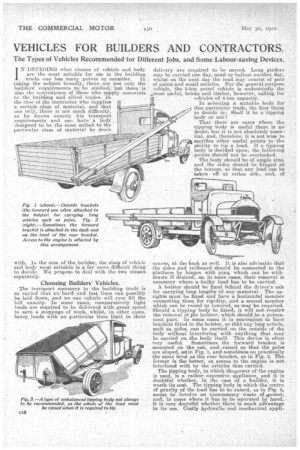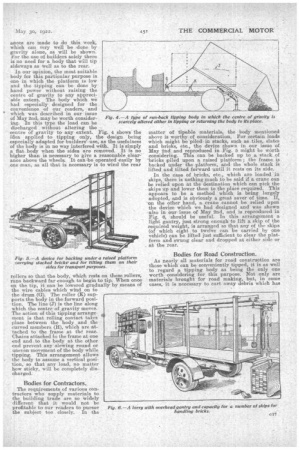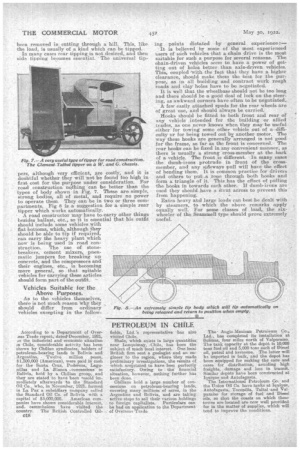VEHICLES FOR BUILDERS AND CONTRACTORS.
Page 10

Page 11

Page 12

If you've noticed an error in this article please click here to report it so we can fix it.
The Types of Vehicles Recommended for Different jobs, and Some Labour-saving Devices.
IN DEOIDING what classes of vehicle and body are the imost suitable for use in the building trade one has 'many points tin consider. Intaking the subject broadly, ther.e are not only the builders' requirements to be studied;but there is also the convenience of those who supply materials to the building and allied trades. In the case of the contractor who supplies a certain, ,class of material, and that one only, there is not much difficulty, as he knows exactly his transport requirements and can haye a body designed to be the most suited to the particular class of material he deals
with. In the case of the builder, the class of vehicle and body most suitable is a far more difficult thing to decide. We propose to deal with the two classes separately.
Choosing Builders' Vehicles.
The transport necessary in the building trade is so varied that no hard and fast lines can possibly be laid down, and no one vehicle will ever fill the bill exactly. In some cases, comparatively light loads are required to be delivered with great speed to save a stoppage of work, whilst, in other eases, heavy loads with no particular time limit to their
delivery are required to be moved. Long girders may be carried one day, sand or ballast another day, , whilston the next day the load may consist of pots of paint arid small aiticles. For the general-purpose vehicle, the 3-ton petrol vehicle is undoubtedly the most useful, bricks and timber, however, calling for vehicles of 4-ton capacity.
In selecting a suitable body for this particular trade, the first thing to decide is: Shall it be a tipping body or not?
That there are cases where the tipping body is useful there is no doubt, but it is not absolutely essential, and, therefore, it is not wise to sacrifice other useful points to ,the ability to tip a load. If a tipping
body is decided upon, the following points should not be overlooked.
The body should be of ample size, and the sides should be hinged at the bottom, so that any load can be taken off at either side, and, of course, at the back as well. It is also advisable that the sides and tailboard should be connected to the platform by hinges with pins, which can be withdrawn if desired, as, in some cases, their removal is necessary where a bulky load has to be carried.
A bolster should be fixed behind the driver's cab for carrying long lengths of any material. The uprights must be fixed and have a horizontal member connecting them for rigidity, and a second member which can be raised Or lowered, as may be required. Should a tipping body be fitted, it will not require the'reinoval of the bolster, which should be a permanent part: In some eases it is convenient to have brackets fitted to the bolster, so thht any long article, such as poles, can be carried on the outside of he body without interfering with anything that may be carried on the body itself. This device is often very useful. Sometimes the forward bracket is mounted on the cab, and raised so that the poles are sloped, as' in Fig. 1, and sometimes on practieally the same level as the rear bracket, as in Fig. 2. The former is the 'better, as access to the engine is not interfered with by the articles thus carried.
The tipping body, in which the,power of the engine is used, is a rather expensive appliance, and it is doubtful whether, in the ease of a builder, it is worth its cost. The tipping body in which the centre of gravity of the load has to be raised, as in Fig. 3, seems to involve an unnecessary waste of Rower, and, in cases where it has to be operated by hand, it is very doubtful whether there is much advantage in its use. Costly .hydraulic -and mechanical appli anees are made to do this work, which can very well be -done by gravity alone, as will be shown. .?or the use of builders solely there is no need for a body that will tip sideways as well as to the rear.
In our opinion, the most suitable body for this partieular purpose is One in which the platform is low and the tipping can be done by hand power without raising the centre of gravity to any appreciable extent. The body which we had especially designed for the convenience -of our readers, and
' which was described in our issue of May 2nd, may be worth considerFig. 4.—A type ing. In this type the load can be scarcely al discharged without altering the centre of' gravity to any extent. Fig. 4 shows the idea applied to tipping only, the design being especially adapted for builders' use, as the usefulness of the body is in no way interfered with. It is simply a flat body when the aides are removed. It is no higher than is necessary to give a reasonable clear-' ance above the wheels. It can-be operated easily by one man, as all that is necessary is to wind the rear
rollers so that the body, which rests on these rollers, runs backward far enough to begin to tip. When once on the tip, itecan be lowered gradually by means of the wire cables which wind on to
the drum ((I). The roller (10 supports the body in the forward position. The line (.1) is the line along which the centre of gravity moves. The action of this tipping arrangement is that rolling contact takes place between the body and the curved members (H), which are attached to the frame at the rear. Chains attached to the frame at one end and. to the body at the other end prevent any slewing round or uneven movement of the body while tipping. This arrangement allows the body to assume a vertical position, so that any load, no matter how sticky, will be completely discharged.
Bodies for Contractors.
The requirements of various contractors who supply materials to the building trade are so widely different that it would not be profitable to our readers to pursue the subject too closely. In the
matter of tipable materials, the body mentioned above is worthy of consideration. For certain loads which might be piled in stacks, such as tiles, slates and bricks, etc., the device shown in our issue of May 2nd and reproduced in Fig. 5 might be worth considering. This can be backed up to a stack of -bricks piled upon a raised platform ; the frame backed under the platform, and the whole stack is lifted and tilted forward until it rests on its side.
In the case of bricks, etc., which are loaded in skips, there is nothing trawl te, be said if a crane can be relied upon at the destination which can pick the skips up and lower them to the place required. This appears to be a method which is being largely adopted, and is obviously a great saver of time. If, on the other hand, a crane cannot be relied upon the device which we had designed and was shown also in our issue of May 2nd, and is reproduced in Fig. 6, should be useful. In this arrangement a light gantry, just strong enough to lift a skip of the required weight, is arranged so that any of the skips (of which eight to twelve eaii be carried by one vehicle) can be lifted just sufficient to clear the platform and swung clear and dropped at either side or at the rear.
Bodies for Road Construction.
As nearly all materials for road construction are those which can be conveniently tipped, it is as well to regard a tipping body as being the only one worth considering for this purpose. Not only are materials brought for road making, but, in some cases, it is necessary to cart away debris which has
been removed in cutting through a hill. This, like the load, is usually of a kind which can be tipped. In many cases rear tipping is not desired, and then side tipping becomes essential. The universal tip
pers, although very efficient, are costly, and it is doubtful whether they will not be found too high in first cost for the purpose under consideration. For road construction nothing can be better than the types of body shown in Fig. 7. These are simple, strong bodies., all of metal, and require no power to operate them They can be in two or three compartments. Fig 8 is a suggestion for a simple rear tipper which works automatically. A road constructor may have to carry other things besides ballast, etc., so it is essential that his outfit should include some vehicles with flat bottoms, which,. although they should be able to tip if required, can carry the heavy plant which now is being used in road construction. The • use of stonebreakers, cement mixers, pneumatic jumpers for breaking up concrete, and the compressors anu their engines, etc., is becoming more general, so that suitable vehicles for carrying these articles should form part of the outfit.
Vehicles Suitable for the Above Purposes.
As to the vehicles themselves, there is not much reason why they should differ from ordinary vehicles excepting in the follow lug points dictated by general experience:—
it is believed by some of the most experienced users of such vehicles that a chain drive is the most suitable for such a purpose for several reasons. The chain-driven vehicles seem to have a power of getting out of holes better than axle-driven vehicles. This, coupled with the fact that they have a higher clearance, should make them the best for the purpose, as in all building and contract work rough roads and clay holes have to be negotiated.
It is well that the wheelbase should not be too long and there should be a good deal of lock on the steering, as awkward corners have often to be negotiated.
A few easily attached spuds for the rear wheels arc of great use, and should always be carried.
Hooks should be fitted to both front and rear of any vehicle intended for the building or allied ,trades, as one never knows when they may be useful either for towing some other vehicle out of a difficulty or for being towed out by another motor. The way these hooks are generally arranged is not good for the frame, so far as the front is concerned. The. rear hooks can be fixed in any convenient. manner, as there is usually a strong cross-member at the hack of a vehicle. The front is different. In many cases the dumb-irons protrude, in front of the crossmember, and any sideways pull will have the effect of bending them. It is common practice for drivers and others to put ,a rope through both hooks and form a triangle of it.' This.has the effect of pulling the hooks in towards each other. If dumb-irons are used they should have a gtrut across to prevent this from happening.
Extra heavy and large loads can best be dealt with by steamers, to which the above remarks apply equally well. For some classes of load, the sixwheeler of the Scammen type should prove extremely useful.












































